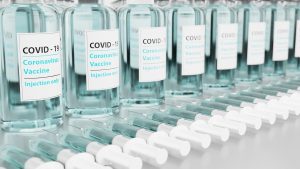With two new COVID-19 vaccines having just been given the green light to roll out in China, four distinct brands are now available to the Chinese population, and all four are made in China.
One might think that China’s choice to use, for the moment at least, only domestically-produced COVID-19 vaccines is a function of market forces, particularly supply and demand, and cost. And if Chinese vaccines were achieving more or less the same efficacy in trials, and effectiveness among the vaccinated population as some vaccines made outside of China are reaching, then it would make sense that Beijing would rely primarily upon its own domestic pharmaceutical manufacturing capabilities to provide for its own population. If on top of that production came in at a likely lower cost than foreign vaccines, then the business model would be perfectly logical.
But that is not the case. Vaccines produced by two American pharmaceutical companies, Moderna and Pfizer, both achieved efficacy rates of 95 percent. Yet, China has not approved them.
Chinese vaccines, on the other hand, are reported to be achieving effectiveness rates as low as 50 percent, and generally within the 60 to 68 percent range. These vaccines are being used not only in China, but also in countries to which China is selling, and often donating, shots.
A note for technical clarity: As the United Nations Office for the Coordination of Humanitarian Affairs (OCHA) explains, “efficacy” is the term, that “measures a vaccine’s protection against a disease/pathogen in a vaccine trial.” “Effectiveness,” on the other hand, refers to a vaccine given “outside a clinical trial.” OCHA’s guidance goes on to say that “compared with efficacy, effectiveness takes into account all the complexities of the real world, outside of a controlled clinical trial setting.”
The case can be made that the development of safe, effective, and timely vaccines for COVID-19 is China’s biggest pharmaceutical challenge to date. Given that China is trying to become the largest pharmaceutical player globally within 10 years, its ability to meet the COVID-19 vaccine challenge is of enormous significance not only within the industry, but also to the general public around the world who could be consumers of that industry.
As China-based Daxue Consulting writes in its recent analysis of the pharmaceutical industry in China, “The rapid rise of China’s healthcare industry has allowed it to begin the transition from being a pharmaceutical manufacturing base to a strategic R&D hub.”
Daxue says that China currently holds 11 percent of the global pharmaceutical market. China’s largest market is, not surprisingly, the United States. But, in order to achieve global dominance by 10 years from now, “the pharmaceutical market in China has a lot of consolidation to do.”
Noting that China has adopted a “top-down approach” to “reinvent its pharmaceutical industry,” Daxue points out that enormous amounts of research and development, along with corresponding levels of investment, are needed to bring China’s pharmaceuticals capability up to international standards.
China has managed to produce vaccines that report significant efficacy. However, those efficacy statistics are not world beaters. They come in a quarter to 50 percent below the levels of the top two vaccines produced by the United States, one in conjunction with Germany.
There is no question that the Chinese vaccines can play a role in combating the worst effects of COVID-19. As Nature reports, “Researchers in Brazil reported that CoronaVac, developed by Beijing-based Sinovac, was 50.4% effective at preventing severe and mild COVID-19 in late-stage trials.” But, they point out, “that’s significantly lower than the 90% efficacies of several leading vaccines.” A delayed roll-out of official, complete data from the vaccine developers has not helped raise confidence.
Most importantly, however, the homegrown Chinese vaccines seem to not have captured the trust of the Chinese public. In a country in which bucking the party line can be risky, many Chinese citizens are turning away from the opportunity of receiving one of the Chinese versions of the vaccine. That even includes healthcare workers.
“Sophia Qu, a doctor at a hospital in Guangdong Province…didn’t take up the vaccine offer because she’s worried about negative side effects. Fewer than half her colleagues got vaccinated, she said,” reported Bloomberg.
Recurring scandals over expired or tainted vaccines used for routine immunizations have eroded public trust in the Chinese vaccine industry even for well-established shots – much less for the newly created COVID-19 vaccines.
What does it say about the politicization of COVID-19 by Chinese leadership that it has not yet approved foreign vaccines, with much higher effectiveness rates, for introduction into the Chinese market? Leadership knows that its new middle and upper classes crave foreign goods for their standards reliability, especially food and wellness products. Ignoring the desire of a significant, well-heeled portion of the population for a vaccine that is proven to offer almost complete immunity from the virus is a risky strategy.
Logic does not seem to be governing much if anything related to the COVID-19 pandemic, and China’s seeming insistence, at least for the time being, on limiting its citizens to Chinese-made vaccines is yet another example of politics dominating reason. More importantly, China’s failure to achieve a vaccine that comes even close to reaching the efficacy of not one, but two Western-produced vaccines highlights the complex path that China has to achieving its self-imposed target of leading the world in the pharmaceutical industry just 10 short years from now.
The politicization of the COVID-19 pandemic and best practices for management and treatment has been seen in many countries in 2020. Politicization, it is evident, is also a factor in China’s vaccine protocols.
































